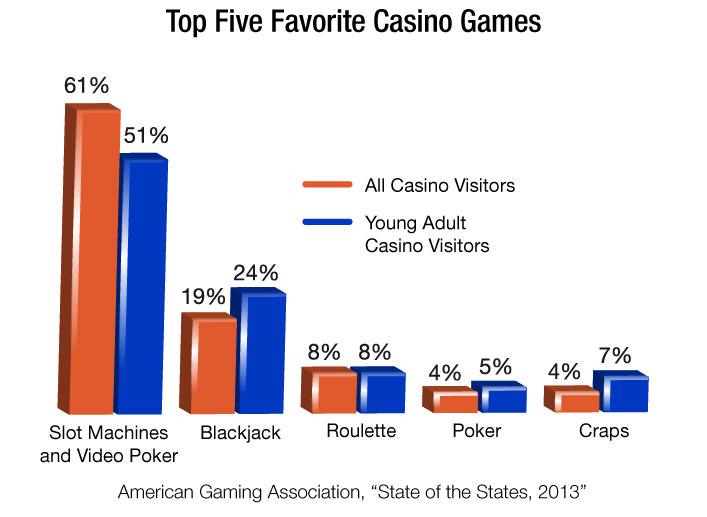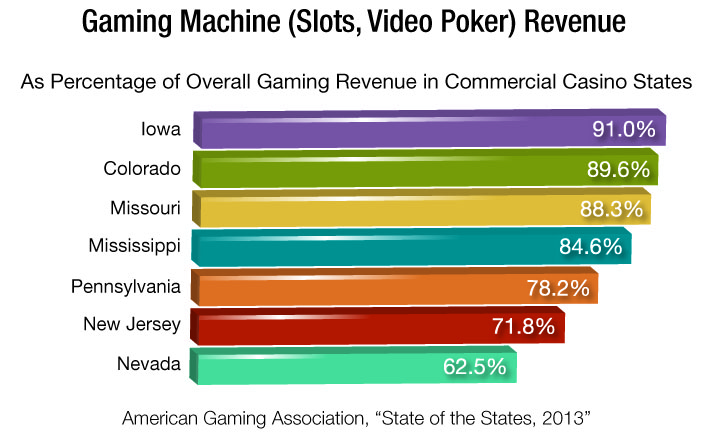
DOWNLOAD ENTIRE ARTICLE (with images and endnotes)
The Social and Economic Harms of Casino Gambling
Increasingly across the United States, the gambling industry is seeking to expand its reach through “regional casinos” that bring Las Vegas-style gambling to Main Street—creating easy access and temptation for citizens to gamble closer to home, often several times a week. According to a recent report, 23 states have some form of commercial casinos, creating an environment where “nearly every adult” in the Northeast and mid-Atlantic states “now lives within a short drive of a casino.”
North Carolina is no stranger to the efforts of the gambling industry to expand casino gambling. In 2011, then-Governor Beverly Perdue signed an “Amended and Restated Gambling Compact” with the Eastern Band of Cherokee Indians (EBCI), which was the first step in enabling the Cherokee Tribe to implement “Class III” Las Vegas-style table games (such as craps, roulette, blackjack, and poker) with live dealers in North Carolina. The General Assembly followed suit in June 2012 by enacting legislation that authorized the EBCI to conduct these Class III games, and allowed the Tribe to operate up to three casinos. The U.S. Department of the Interior approved these changes in August 2012, and in October 2013, the Cherokee broke ground on a second casino near Murphy, N.C. that will reportedly hold up to 1,200 slot machines and 40-50 live table games. If that were not enough, it became public in August 2013 that the South Carolina-based Catawba Indian Nation is seeking to purchase land and build a 220,000 square-foot gambling casino and “resort” off of I-85 in Cleveland County, North Carolina (near Charlotte).
Regional casinos are sold to the public as a “sure” source of revenue for hurting economies, with the promise of more jobs and increased tourism. But a groundbreaking new report from 33 noted scholars and policy leaders shows that regional casinos are a “regressive source of income for states” that ultimately bring harm to the communities in which they are located. According to the report, casinos prey upon the most vulnerable citizens for the majority of their revenue, weaken other businesses, and harm property values. Released in September 2013 by the Institute for American Values’ Council on Casinos, the report, “Why Casinos Matter: 31 Evidenced-Based Propositions from the Health and Social Sciences,” differs from the majority of other U.S. gambling studies by relying primarily on independent research that is not associated with or controlled by the gambling industry. The report argues that state-promoted casino gambling “is contributing to economic inequality,” and urges state governments to rethink their involvement in its expansion.
Following is a compilation of findings from the “Why Casinos Matter” report, along with additional research, that shows why the social and economic costs of casino gambling far outweigh any potential, short-term benefits for communities.
1. Today’s casinos are dominated by computerized slot machines, from which casinos derive the majority of their revenue.
- The number of legal electronic gambling machines, which include slots, has increased by more than five fold in the U.S. in less than two decades—from about 184,000 in 1991 to about 947,000 in 2010.
- There are 3,145 electronic gambling machines in North Carolina, according to the American Gaming Association (AGA).
- According to the AGA, 61 percent of casinogoers say that electronic slot and video poker machines are their favorite casino games.
- According to the “Why Casinos Matter” report, “The percentage of casinos’ total gambling revenue deriving from slot machines is estimated at 62 to 80 percent, with racinos (racetrack casinos) getting 90 percent of their take from slots.”

2. Slot machines are highly addictive electronic devices that are designed to induce gamblers to spend more time on the machine and to play until all their money is gone.
- Electronic gambling machines (i.e., slot and video poker machines) have been dubbed the “crack cocaine” of gambling by experts.
- According to MIT Professor Natasha Dow Schull, who spent over a decade researching machine gamblers in Las Vegas, “Every feature of a slot machine—its mathematical structure, visual graphics, sound dynamics, seating and screen ergonomics—is calibrated to increase a gambler’s ‘time on device’ and to encourage ‘play to extinction,’ which is industry jargon for playing until all your money is gone.”
- In her book, Addiction by Design, Dr. Schull quotes a gambling industry consultant as telling her, “The key [to machine gambling] is duration of play. I want to keep you there as long as humanly possible—that’s what makes you lose.”
- One major study found that people who play slot machines as “their primary form of gambling are more likely to become problem gamblers,” and “to experience more rapid onset of gambling addiction than people who engage in more traditional forms of gambling.”
- According to gambling addiction experts, it typically takes one to three years to develop a gambling problem with modern slot machines, versus five to 10 years with traditional forms of gambling.
3. Areas where casinos are introduced and expanded experience significant increases in the number of problem and pathological gamblers.
- Nationwide, it is estimated that over five percent of the adult population has exhibited the characteristics of pathological or problem gambling during their lifetime.
- The percentage of problem and pathological gambling among regular (or repeat) gamblers is estimated to be as high as 20 percent, according to Dr. Schull.
- According to the “Why Casinos Matter” report, “in some states, the rate of problem gambling rises three to four-fold after the initial adoption of a casino before leveling off at this higher level or declining modestly.”
- A 2004 study found that individuals who lived within 10 miles of a casino had twice the rate of pathological and problem gambling as individuals who did not.
4. Casinos are disproportionately dependent on problem gamblers for the majority of their profits.
- According to the “Why Casinos Matter” report, “problem gamblers account for 40 to 60 percent of slot machine revenue.”
- One Canadian study found that “casual players comprised 75 percent” of the number of people gambling in casinos, while contributing only four percent of net revenue. The majority of casino revenue came from problem gamblers.

5. Increasing numbers of addicted gamblers create significant burdens for gamblers, their families, and society.
- Individuals who have gambling problems are more likely to suffer from other addictive behaviors, and experience increased depression and anxiety.
- Addicted gamblers are more likely to get divorced, experience financial hardship (bankruptcy/ debt), lose their home or job (or both), attempt suicide, and commit spousal abuse.
- Families of problem gamblers report increased physical and emotional abuse of spouses and children, divorce, child neglect, and alcohol and drug abuse.
6. In addition to increased gambling addiction, crime increases in areas where casino gambling is introduced.
- Addicted gamblers often resort to criminal activity to fuel their gambling addiction and/ or to pay off large debts.
- A report by the Attorney General’s Office in Maryland found that introducing casinos within the State would increase organized crime, child abuse, drug abuse, and domestic violence.
- In the first 15 years in Atlantic City after casinos were built, violent crime rose 199 percent and larceny increased 481 percent.
- In North Carolina, during the first five years of the Cherokee Casino, crime rates in that county were reported to have increased 25 percent, and the Jackson County police force increased by 40 percent, while the number of officers on the reservation increased by 33 percent.
- A survey of nearly 400 Gamblers Anonymous members found that 57 percent committed theft that amounted to stealing $30 million collectively to fund their gambling addictions (an average of $135,000 per gambler).
7. Gambling addiction and its associated costs are expensive for society.
- A 2010 national evaluation of gambling costs by Focus on the Family estimated that pathological gambling in adults costs about $12,205 per addicted gambler, per year in the United States. The report estimated that problem gambling costs $3,478 per adult problem gambler, per year.
- According to the “Why Casinos Matter” report, a “2004 study estimated the social costs of problem gambling associated with a new casino between $2,486 and $2,945 per problem gambler, and $5,143 to $10,330 per additional pathological gambler.
8. Regional casinos negatively impact the economies of host and surrounding communities, and serve as a regressive form of revenue for states. According to the 2013 “Why Casinos Matter” report:
- Casinos “build their customer base by encouraging repeat visits from local residents…. Repeat players spend dollars in a casino that would otherwise be spent somewhere else in the local economy.”
- Casinos hurt property values in the host community. For example, “research conducted for realtors in western Massachusetts, where a new regional casino is slated for construction, found that homeowners in the host community would experience from $1,650 to $3,300 in lost value.” The same study estimated an additional 125 home foreclosures each year.
- Casinos weaken other businesses, such as restaurants and bars, while increasing gamblingassociated businesses, such as pawnshops, check cashing stores, and payday lenders.
- “A study that looked at the spread of casino gambling in 300 Metropolitan Statistical Areas found that the presence of a casino reduces voluntarism, civic participation, family stability, and other forms of social capital within 15 miles of a community where it is located.”
- Ultimately, “the fundamental economic dynamic of a regional casino is taking dollars out of the community, not bringing dollars into the community.”
DOWNLOAD ENTIRE ARTICLE (with images and endnotes)
Alysse ElHage, M.A., is associate director of research for the North Carolina Family Policy Council.


